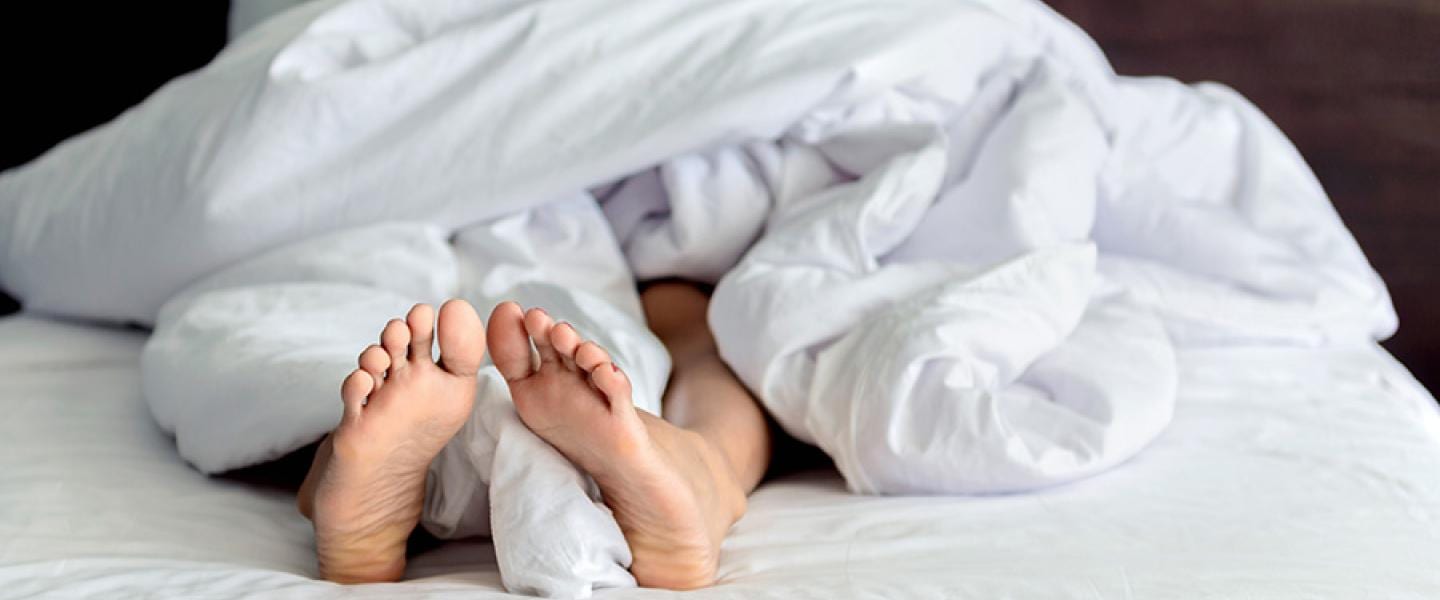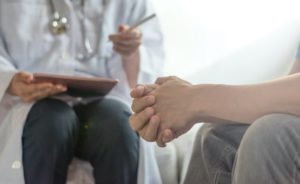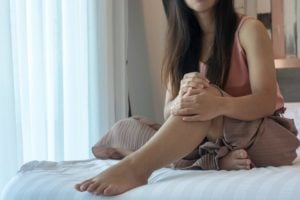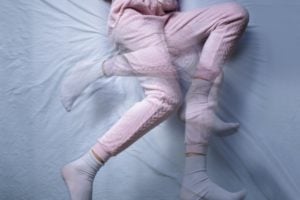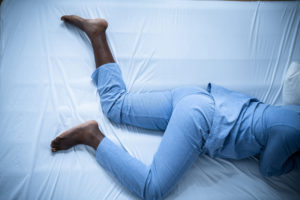Treatment for Restless Legs Syndrome (RLS)
- Home remedies like massage, heat, and exercise can relieve symptoms of RLS.
- If lifestyle changes and relaxation techniques before bed do not alleviate restlessness, talk to your doctor.
- Devices that provide compression or vibration can reduce RLS discomfort.
- Medications and iron supplements may be prescribed for RLS treatment.
Restless legs syndrome (RLS), otherwise known as Willis-Ekbom disease, is a disorder characterized by uncomfortable tingling sensations and an irresistible urge to move the legs. Symptoms appear to follow the circadian rhythm, usually getting worse at night and often interfering with sleep.
Restless legs syndrome treatment aims to reduce discomfort from symptoms and improve sleep quality. While RLS symptoms may never fully go away , they can be significantly improved through a combination of lifestyle changes, vitamin and mineral supplements, medical devices, and medication.
Is Your Troubled Sleep a Health Risk?
A variety of issues can cause problems sleeping. Answer three questions to understand if it’s a concern you should worry about.
Establishing a Treatment Plan for Restless Legs Syndrome
When treating RLS , doctors must consider the severity of the condition and the extent to which it affects your quality of life. Due to the potential for side effects, doctors may prefer to avoid prescribing medication for mild symptoms that don’t interfere with day-to-day life.
Since RLS can occur on its own or as a result of another medical condition, treatment for RLS symptoms may need to be approached differently depending on the root cause. Before proceeding with RLS treatment, experts recommend looking for other conditions that could be causing or aggravating RLS symptoms . Common culprits include:
- Sleep deprivation
- Stress
- A sedentary lifestyle
- Obesity
- Alcohol, nicotine, caffeine use
- Pregnancy
- Diabetes
- Sleep-disordered breathing
- Peripheral neuropathy
- Renal insufficiency
- Medication such as antihistamines and certain antidepressants
For many people, addressing these factors may lead to a drastic reduction in RLS symptoms. However, if symptoms are still bothersome, or if they interfere with sleep, doctors may advise additional remedies.
Restless Legs Syndrome and Nutrition
Many cases of RLS are associated with iron deficiency , which can be treated with iron supplements. These have few side effects apart from stomach complaints and constipation, and they work to reduce symptoms of RLS in many people with low iron and ferritin levels or iron-deficiency anemia. After checking your iron and ferritin levels, your doctor may prescribe iron supplements alone or in conjunction with other medications.
Other vitamins and minerals such as magnesium , zinc , and vitamin D may also play a role in RLS. Pregnant women in particular may benefit from folate supplements , while people with kidney problems may benefit from vitamin C and E supplements .
Home Remedies for Restless Legs Syndrome
Home remedies offer a simple way to improve RLS symptoms. Though more research is needed to confirm how effective these methods are, many people with mild to moderate RLS symptoms find relief from a combination of the following:
- Moving the legs: Moving the affected body part usually leads to relief from uncomfortable sensations, though symptoms may return when movement ceases.
- Implementing healthy sleep hygiene habits: RLS can cause sleep loss , but it’s also exacerbated by sleep problems. Try to keep a regular sleep schedule and ask your doctor for personalized sleep hygiene tips.
- Avoiding tobacco and eating a healthy diet: The Restless Legs Syndrome Foundation recommends reducing alcohol, caffeine, sugar, and salt and following a healthy diet rich in vitamins and minerals. In addition to relieving RLS symptoms, a healthy diet can help improve sleep quality.
- Exercising: Moderate exercise and stretching may help reduce RLS symptoms. That said, people with RLS should be careful with high-intensity activity, which may cause muscle cramps and stiffness that can exacerbate symptoms.
- Receiving massages or self-massaging: Some people find relief from RLS symptoms after massaging affected areas.
- Using heat or cold: RLS-related discomfort can often be tamed by applying a hot or cold compress or taking a warm bath before bed. Response to temperature may vary from person to person.
Researchers have also proposed acupuncture, electrical stimulation, transcranial magnetic stimulation, sclerotherapy for varicose veins, infrared light, yoga, and other methods for relieving RLS symptoms . However, there is limited research on whether these treatments are effective, and whether the benefits outweigh the risks.
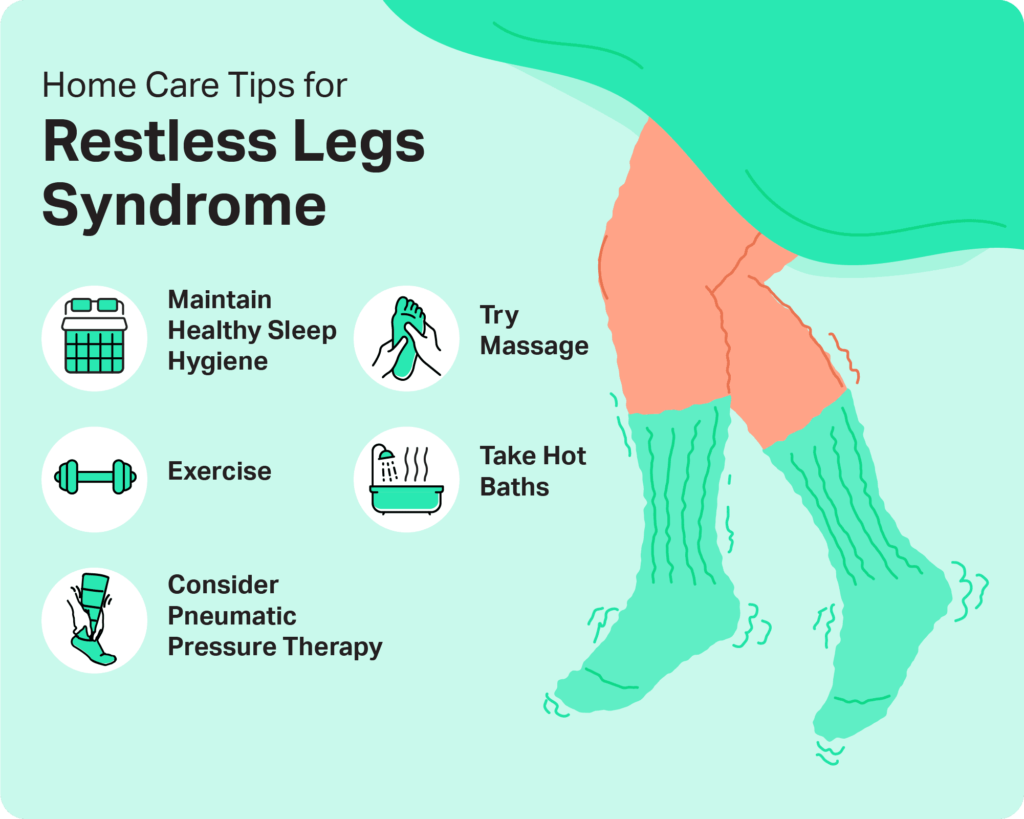
Medical Devices for Restless Legs Syndrome
New attention is being given to the possibility of using medical devices to improve RLS symptoms. Similar to the way that moving the legs gives temporary relief, these medical devices aim to reduce discomfort of RLS symptoms by providing external stimulation .
So far, the Food and Drug Administration (FDA) has approved two medical devices as RLS treatments: a compression foot wrap and a vibrating pad. Both are available by prescription and designed for people with moderate to severe RLS.
The foot wrap works by applying targeted pressure to the affected area, usually the lower leg or foot. By contrast, the vibrating pad uses counter-stimulation to mask RLS symptoms and improve sleep quality. Both devices are considered fairly safe, though they may not be suitable for people with certain underlying health conditions.
Some physicians also recommend using a pneumatic compression device to ease RLS symptoms. It’s thought that compression of the veins helps boost circulation and reduce the uncomfortable sensations caused by RLS.

Restless Legs Syndrome Medication
Medication is currently considered the gold standard for people with moderate to severe RLS. To reduce the risk of unpleasant side effects, always work with a doctor to find the medication that’s right for you.
People with RLS resulting from another condition, or those with another consideration such as pregnant women, children, people with anxiety or depression, or individuals with kidney disease, may need to exercise extra caution when taking medication(s).
RLS can be treated with several different families of medications, the most common being dopamine agonists and anti-seizure drugs.
Dopamine Agonists
Drugs that target dopamine receptors are one of the most effective treatments for RLS. Dopamine agonists can be taken in pill form approximately two hours before bedtime or administered continuously through a patch. The FDA has currently approved three dopamine agonists for RLS: pramipexole, ropinirole, and rotigotine.
A major side effect of dopaminergic drugs is augmentation (progressive worsening) of RLS symptoms, which can come in many forms. Symptoms may appear earlier in the day, they may become more intense, they may spread to other parts of the body, or higher doses of the drug may be needed for it to remain effective. These side effects could be mistaken for a natural progression of RLS, but they are typically reversed once the patient stops using the drug. Adjusting the drug’s timing and dosage may reduce augmentation.
Other potential side effects include a rebound of symptoms in the morning, a growing tolerance to the drug, nausea, dizziness, sleepiness, insomnia, orthostatic hypotension, and impulsive or compulsive behaviors such as gambling.
Anti-Seizure Drugs
Anti-seizure drugs are often used for people who experience pain along with their other RLS symptoms. These drugs are gaining popularity as an RLS treatment because they seem to work as well as dopaminergic agonists, but are less likely to cause augmentation of RLS symptoms.
The FDA has approved gabapentin enacarbil for use in RLS, preferring it over standard gabapentin because it has fewer side effects. Another similar drug, pregabalin , also shows promising results for RLS symptoms and sleep quality, and carries a low risk of side effects.
The FDA warns that anti-seizure drugs may cause dangerous breathing difficulties , especially for people already at risk, such as the elderly or those with lung disease, and for those who are also taking opioids or benzodiazepines. Anti-seizure drugs can also cause augmentation of RLS symptoms, though they are not as likely as dopaminergic drugs to do so. Finally, people taking anti-seizure drugs can experience problems with dizziness, fatigue, and sleepiness.
Benzodiazepines
Benzodiazepines don’t have a direct effect on RLS symptoms, but they may help individuals with RLS sleep more soundly.
Because of the potential for developing a tolerance, most doctors prescribe benzodiazepines only if other drugs don’t work. People with sleep apnea may find that benzodiazepines make their symptoms worse. Benzodiazepines can also cause next-day sleepiness, fatigue, and difficulty concentrating.
Opioids
Low doses of opioids are a last-line treatment for people with severe RLS symptoms that do not respond to other treatments.
Opioids are highly addictive, and most people develop a tolerance that leads to them needing higher and higher doses over time. Other side effects of opioids include constipation, nausea, dizziness, and worsening of sleep apnea.
Other Drugs
A few substances, such as valerian and valproic acid, are sometimes used to treat RLS despite not being FDA-approved. Due to the lack of research on their efficacy and side effects, the American Academy of Sleep Medicine recommends against using these for RLS.
Tips for Coping With Restless Legs Syndrome
Learning to recognize and avoid your personal triggers can help you manage RLS over time.
Effective techniques for minimizing RLS symptoms vary from person to person. Many people find relief from keeping active throughout the day and using acupuncture, massage, stretching, or relaxation techniques at night. During the day, you may be able to ward off RLS symptoms by keeping your mind busy even when you are sitting still with activities like reading or chatting to a friend.
Though RLS is not life-threatening, the frustration of not being able to sleep well can take a toll on mental health. Cognitive behavioral therapy, support groups, or reaching out to family and friends may provide additional emotional resources for coping with RLS.
References
19 Sources
-
National Institute of Neurological Disorders and Stroke. (2020, March 17). Restless Legs Syndrome Fact Sheet., Retrieved January 21, 2021, from
https://www.ninds.nih.gov/Disorders/Patient-Caregiver-Education/Fact-Sheets/Restless-Legs-Syndrome-Fact-Sheet -
Winkelman, J. W., Armstrong, M. J., Allen, R. P., Chaudhuri, K. R., Ondo, W., Trenkwalder, C., Zee, P. C., Gronseth, G. S., Gloss, D., & Zesiewicz, T. (2016). Practice guideline summary: Treatment of restless legs syndrome in adults: Report of the Guideline Development, Dissemination, and Implementation Subcommittee of the American Academy of Neurology. Neurology, 87(24), 2585–2593.
https://pubmed.ncbi.nlm.nih.gov/27856776/ -
Garcia-Borreguero, D., Silber, M. H., Winkelman, J. W., Högl, B., Bainbridge, J., Buchfuhrer, M., Hadjigeorgiou, G., Inoue, Y., Manconi, M., Oertel, W., Ondo, W., Winkelmann, J., & Allen, R. P. (2016). Guidelines for the first-line treatment of restless legs syndrome/Willis-Ekbom disease, prevention and treatment of dopaminergic augmentation: a combined task force of the IRLSSG, EURLSSG, and the RLS-foundation. Sleep Medicine, 21, 1–11.
https://pubmed.ncbi.nlm.nih.gov/27448465/ -
Aurora, R. N., Kristo, D. A., Bista, S. R., Rowley, J. A., Zak, R. S., Casey, K. R., Lamm, C. I., Tracy, S. L., Rosenberg, R. S., & American Academy of Sleep Medicine (2012). The treatment of restless legs syndrome and periodic limb movement disorder in adults—n update for 2012: Practice parameters with an evidence-based systematic review and meta-analyses: An American Academy of Sleep Medicine Clinical Practice Guideline. Sleep, 35(8), 1039–1062.
https://pubmed.ncbi.nlm.nih.gov/22851801/ -
Marshall, N. S., Serinel, Y., Killick, R., Child, J. M., Raisin, I., Berry, C. M., Lallukka, T., Wassing, R., Lee, R. W., Ratnavadivel, R., Vedam, H., Grunstein, R., Wong, K. K., Hoyos, C. M., Cayanan, E. A., Comas, M., Chapman, J. L., & Yee, B. J. (2019). Magnesium supplementation for the treatment of restless legs syndrome and periodic limb movement disorder: A systematic review. Sleep Medicine Reviews, 48, 101218.
https://pubmed.ncbi.nlm.nih.gov/31678660/ -
Chen, P., Bornhorst, J., Patton, S., Bagai, K., Nitin, R., Miah, M., Hare, D. J., Kysenius, K., Crouch, P. J., Xiong, L., Rouleau, G. A., Schwerdtle, T., Connor, J., Aschner, M., Bowman, A. B., & Walters, A. S. (2020). A potential role for Zinc in Restless Legs Syndrome. Sleep, zsaa236. Advance online publication.
https://pubmed.ncbi.nlm.nih.gov/33175142/ -
Jiménez-Jiménez, F. J., Alonso-Navarro, H., García-Martín, E., & Agúndez, J. (2019). Neurochemical features of idiopathic restless legs syndrome. Sleep Medicine Reviews, 45, 70–87.
https://pubmed.ncbi.nlm.nih.gov/30965199/ -
Srivanitchapoom, P., Pandey, S., & Hallett, M. (2014). Restless legs syndrome and pregnancy: a review. Parkinsonism & Related Disorders, 20(7), 716–722.
https://pubmed.ncbi.nlm.nih.gov/24768121/ -
Sagheb, M. M., Dormanesh, B., Fallahzadeh, M. K., Akbari, H., Sohrabi Nazari, S., Heydari, S. T., & Behzadi, S. (2012). Efficacy of vitamins C, E, and their combination for treatment of restless legs syndrome in hemodialysis patients: a randomized, double-blind, placebo-controlled trial. Sleep Medicine, 13(5), 542–545.
https://pubmed.ncbi.nlm.nih.gov/22317944/ -
Restless Legs Syndrome Foundation, Restless Legs Syndrome Foundation, & Profile, V. M. C. (2020, April 23). Eating with RLS. Restless Legs Syndrome Foundation Blog.
http://rlsfoundation.blogspot.com/2020/04/eating-with-rls.html -
Park, A., Ambrogi, K., & Hade, E. M. (2020). Randomized pilot trial for the efficacy of the MMF07 foot massager and heat therapy for restless legs syndrome. PLoS One, 15(4), e0230951.
https://pubmed.ncbi.nlm.nih.gov/32240228/ -
Rozeman, A. D., Ottolini, T., Grootendorst, D. C., Vogels, O. J., & Rijsman, R. M. (2014). Effect of sensory stimuli on restless legs syndrome: a randomized crossover study. Journal of clinical sleep medicine : JCSM : official publication of the American Academy of Sleep Medicine, 10(8), 893–896.
https://pubmed.ncbi.nlm.nih.gov/25126036/ -
Food and Drug Administration. (2011, January). De Novo Classification Request For RestifficTM Restless Leg Relaxer Foot Wrap., Retrieved January 21, 2021, from
https://www.accessdata.fda.gov/cdrh_docs/reviews/DEN110009.pdf -
Food and Drug Administration. (2011, July). De Novo Classification Request For Symphony Device., Retrieved January 21, 2021, from
https://www.accessdata.fda.gov/cdrh_docs/reviews/DEN110011.pdf -
Burbank, F., Buchfuhrer, M. J., & Kopjar, B. (2013). Improving sleep for patients with restless legs syndrome. Part II: meta-analysis of vibration therapy and drugs approved by the FDA for treatment of restless legs syndrome. Research and Reviews in Parkinsonism, 3, 11-22.
https://www.dovepress.com/improving-sleep-for-patients-with-restless-legs-syndrome-part-ii-meta--peer-reviewed-article-JPRLS -
Schwab, R.J. (2020, June). Merck Manual Professional Version: Periodic Limb Movement Disorder (PLMD) and Restless Legs Syndrome (RLS).
https://www.merckmanuals.com/home/brain,-spinal-cord,-and-nerve-disorders/sleep-disorders/periodic-limb-movement-disorder-plmd-and-restless-legs-syndrome-rls -
Griffin, E., & Brown, J. N. (2016). Pregabalin for the Treatment of Restless Legs Syndrome. The Annals of Pharmacotherapy, 50(7), 586–591.
https://pubmed.ncbi.nlm.nih.gov/27091870/ -
Center for Drug Evaluation and Research. (2019, December 19). FDA warns about serious breathing problems with seizure and nerve pain medicines gabapentin (Neurontin, Gralise, Horizant) and pregabalin (Lyrica, Lyrica CR). U.S. Food and Drug Administration., Retrieved January 21, 2021, from
https://www.fda.gov/drugs/drug-safety-and-availability/fda-warns-about-serious-breathing-problems-seizure-and-nerve-pain-medicines-gabapentin-neurontin -
Mitchell U. H. (2011). Nondrug-related aspect of treating Ekbom disease, formerly known as restless legs syndrome. Neuropsychiatric disease and treatment, 7, 251–257.
https://pubmed.ncbi.nlm.nih.gov/21654870/


